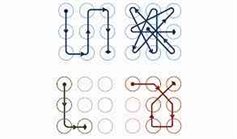ALP Lock patterns
A lock pattern is a user interface element used by various operating systems that regulate immediate access to a device by which the user needs to perform a certain action in order to receive access. In this 21st century, most of us are familiar with this. We know that a lock pattern is very important but when it’s time to come up with good lock patterns for ourselves we are pretty terrible at that.
Android Lock Patterns (ALPs) can contain a minimum of four nodes and a maximum of nine, for a total of nearly 400,000 possible combinations. Thus, we think that this is the better when it comes to android lock pattern, but if you thought so, you might be wrong. For reference, Martel Loge of the Norwegian University of Science and Technology analyzed over 4,000 ALPs for her master’s thesis, what she found was an unfortunate situation.
She found out that 44% of ALPs started from the top left-most node of the screen, while 77% began from one of the four corners. Most often, patterns moved from left to right and top to bottom than from the right to left and the bottom to top. And a large percentage of the designs had only four nodes, dramatically people pull back the pool of available combinations. People usually stay away from patterns that have more changes in direction and are very complex because they tend to be less likely to be guessed.
More the intricate patterns, less the chances of getting access to the phone. Time and again, data breaches show us that people love to use ridiculously bad passwords like “abcde” or “12345” or their phone numbers. But switching to ALPs doesn’t seem to improve our habit of using those simple alphabets and numbers as passwords. In Loge’s study, 10% of the people took patterns after an alphabetic letter or names. Some people in spite of using ALP kept their designs by alphabetic letters or numbers which was very easy to guess, and we could get access to their phones quickly.
So what can you do to make your phone less crackable then? It’s simple. People stop drawing alphabetical letters or numbers. First of all turn off the “make pattern visible” option in your Android settings. Then use crossovers. Try to utilize more than four nodes. They’re giving you nine nodes to set the pattern. So change the directions of the pattern as much as you can and make your lock patterns as complex as possible so that people won’t get access to your phones so easily. And please, for the love of God, don’t save your ALP in a folder named “ALP” on your computer. That’s very much stupid than keeping simple patterns like some alphabets or numbers.







